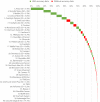Real-world practice level data analysis confirms link between variability within Blood Glucose Monitoring Strip (BGMS) and glycosylated haemoglobin (HbA1c) in Type 1 Diabetes
- PMID: 30168887
- PMCID: PMC6766879
- DOI: 10.1111/ijcp.13252
Real-world practice level data analysis confirms link between variability within Blood Glucose Monitoring Strip (BGMS) and glycosylated haemoglobin (HbA1c) in Type 1 Diabetes
Abstract
Aims/hypothesis: Our aim was to quantify the impact of Blood Glucose Monitoring Strips variability (BGMSV) at GP practice level on the variability of reported glycated haemoglobin (HbA1cV) levels.
Methods: Overall GP Practice BGMSV and HbA1cV were calculated from the quantity of main types of BGMS being prescribed combined with the published accuracy, as % results within ±% bands from reference value for the selected strip type. The regression coefficient between the BGMSV and HbA1cV was calculated. To allow for the aggregation of estimated three tests/day over 13 weeks (ie, 300 samples) of actual Blood Glucose (BG) values up to the HbA1c, we multiplied HbA1cV coefficient by √300 to estimate an empirical value for impact of BGMSV on BGV.
Results: Four thousand five hundred and twenty-four practice years with 159 700 T1DM patient years where accuracy data were available for more than 80% of strips prescribed were included, with overall BGMSV 6.5% and HbA1c mean of 66.9 mmol/mol (8.3%) with variability of 13 mmol/mol equal to 19% of the mean. At a GP practice level, BGMSV and HbA1cV as % of mean HbA1c (in other words, the spread of HbA1c) were closely related with a regression coefficient of 0.176, P < 0.001. Thus, greater variability in the BGMS at a GP practice level resulted in a greater spread of HbA1C readings in T1DM patients. Applying this factor for BGMS to the national ISO accepted standard where 95% results must be ≤±15% from reference, revealed that for BG, 95% results would be ≤±45% from the reference value. Thus, the variation in BG is three times that of the BGMS. For a patient with BG target @10 mmol/L using the worst performing ISO standard strips, on 1/20 occasions (average 1/week) actual blood glucose value could be >±4.5 mmol/L from target, compared with the best performing BGMS with BG >±2.2 mmol/L from reference on 1/20 occasions.
Conclusion: Use of more variable/less accurate BGMS is associated both theoretically and in practice with a larger variability in measured BG and HbA1c, with implications for patient confidence in their day-to-day monitoring experience.
© 2018 John Wiley & Sons Ltd.
Figures





References
-
- International Organization for Standardization 15197 . In vitro diagnostic test systems – Requirements for blood‐glucose monitoring systems for self‐testing in managing diabetes mellitus. In: systems ITCltaivdt, editor. Geneva, Switzerland: International Organization for Standardization; 2013.
-
- Greater Manchester Medicines Management Group . Blood glucose test strips (BGTS) evaluation protocol and results. In: Team MO, editor. Salford, UK: https://www.gmmmg.nhs.uk/docs/guidance/160421-BGTS-Evaluation-Report-Upd.... Accessed November 10, 2017.
-
- Bolinder J, Antuna R, Geelhoed‐Duijvestijn P, Kroger J, Weitgasser R. Novel glucose‐sensing technology and hypoglycaemia in type 1 diabetes: a multicentre, non‐masked, randomised controlled trial. Lancet. 2016;388(10057):2254‐2263. - PubMed
-
- Pearson SM, Ajjan RA. Flash Glucose Monitoring in Younger Individuals with Diabetes: accuracy and Patient Experience in Real‐World Settings. Diabetes Technol Ther. 2018;20(1):4‐5. - PubMed
MeSH terms
Substances
LinkOut - more resources
Full Text Sources
Other Literature Sources
Medical
